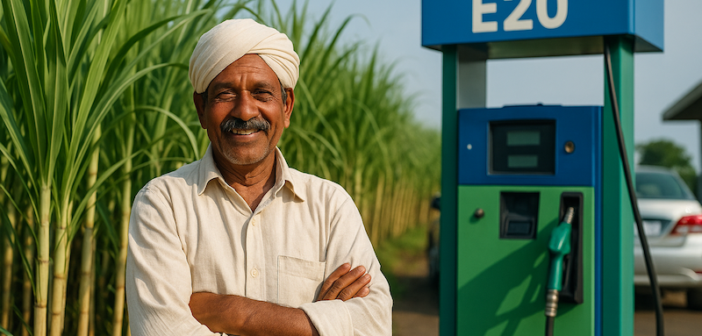TL;DR India achieved its 20% ethanol blending (E20) target in March 2025, five years ahead of schedule, by expanding ethanol production and diversifying feedstocks. As per government data, since the Ethanol Supply Year 2014-15, the EBP Programme has enabled ₹1.21 lakh crore in farmer payments, saved ₹1.40 lakh crore in foreign exchange, replaced 238 lakh metric tonnes of crude oil, and cut 717 lakh metric tonnes of CO₂ emissions. However, there have also been concerns from vehicle owners of older vehicles about E20 fuel damaging engines and giving reduced mileage.
Context
The Ethanol Blended Petrol (EBP) Programme, launched in the early 2000s, aims to reduce crude oil imports, promote green fuel usage to cut CO₂ emissions, and support farmers by providing a stable market for sugarcane and other feedstocks.
Initially, ethanol production was limited to C-heavy molasses, a by-product of sugar production, to avoid affecting sugar supply for direct consumption. However, as India’s blending targets increased to 19.93%, the government in September 2025 lifted restrictions to allow B-heavy molasses, sugarcane juice, sugar syrup, and even direct sugar to be used for ethanol production.
By combining feedstock diversification with financial incentives and fixed ethanol prices, India reached the E20 blending milestone five years ahead of its original 2030 target.
Who Compiles This Data?
Sugarcane production and Fair and Remunerative Prices (FRP) data are published by the Ministry of Agriculture and Farmers’ Welfare in the Reserve Bank of India’s annual publication, Handbook of Statistics on Indian States.
Ethanol production and blending data are sourced from the Ministry of Petroleum and Natural Gas, through roadmap reports and Lok Sabha Questions & Answers.
Where can I download Clean & Structured Data about Sugarcane Statistics?
Clean, structured, and ready-to-use datasets related to Year and State-wise Area, Production and Yield, as well as All India Yearly Fair Remunerative Price of Sugarcane can be downloaded from Dataful, here and here.
Key Insights
Shifts in India’s Sugarcane Output
Sugarcane production in India has experienced notable fluctuations in recent years. After a period of steady growth between FY19 and FY23, production peaked at over 49.05 crore tonnes in FY23. However, it fell to 45.32 crore tonnes in FY24, with a slight dip expected in FY25.
This decline, driven by factors like disease outbreaks and irregular rainfall, has reduced both sugar availability and feedstock for ethanol production, making the balance between food and fuel more critical.
FRP Growth and Its Impact on Farmers
The Fair and Remunerative Price (FRP), which represents the minimum price sugar mills must pay to farmers, has risen steadily over the years, providing a safety net for growers. Starting at ₹275 per quintal in FY19, the FRP has increased to ₹340 per quintal in FY25, an increase of nearly 24%.
Some states, like Uttar Pradesh and Punjab, set higher State Advised Prices (SAP), boosting farmer earnings but increasing financial pressure on mills. These rising prices ensure farmers remain motivated to grow sugarcane despite production challenges.
How Feedstock Pricing Shapes Ethanol Production
The Ethanol Supply Year (ESY) runs from 01 November to 31 October. Since ESY 2018-19, the government has followed a differential pricing policy, offering higher rates for ethanol produced from B-heavy molasses and sugarcane juice to encourage early diversion of cane.
Over the years, B-heavy molasses ethanol prices have remained steady, while C-heavy molasses ethanol prices rose sharply in FY25, making ethanol production more profitable. Ethanol from juice or syrup commands the highest price, incentivising direct diversion when sugar prices fluctuate.
Growth of Ethanol Production and Blending
India’s ethanol production has grown rapidly, with blending levels rising significantly over the past six years. Ethanol supply grew from under 200 crore litres and a 5% blending rate in FY19 to more than 820 crore litres and a 19.9% blending rate in FY25.
The country reached its milestone of 20% ethanol blending (E20) in March 2025, five years ahead of the original 2030 target. This progress has been driven by capacity expansion, feedstock diversification, and stable pricing policies.
Wider Impact on Farmers, Economy, and Environment
As per a government response in the Lok Sabha from August 2025, the ethanol blending program has delivered substantial benefits across multiple fronts. From ESY 2014-15 to June 2025, sugar mills were able to pay more than ₹1.21 lakh crore to farmers, ensuring timely and consistent payments for their sugarcane.
The program also saved ₹1.40 lakh crore in foreign exchange, replaced 238 lakh metric tonnes of crude oil, and cut 717 lakh metric tonnes of CO₂ emissions.
However, there have been concerns from vehicle owners of older vehicles about E20 fuel damaging engines and giving reduced mileage.
Why Does It Matter?
Ethanol blending links agriculture, energy, and the environment. It provides farmers with stable incomes through FRP and ethanol demand, gives mills diversified revenue streams, and helps India save foreign exchange while cutting carbon emissions. As India moves toward E30 blending, balancing food security, sugar availability, and fuel needs will be essential, along with ensuring consumers do not lose out on vehicle maintenance & mileage in the long run.
Key Numbers (from 2018-19 to 2024-25)
- Sugarcane Production (FY, in crore tonnes):
2018-19: 40.54 → 2021-22: 43.94 → 2024-25: 45.01 - Fair Remuneration Price (FY, in rupees per quintal):
2018-19: 275 → 2021-22: 290 → 2024-25: 340 - Ethanol Supplied (ESY, in crore litres):
2018-19: 188.60 → 2021-22: 332.00 → 2024-25: 820.53 - Blending % (ESY, in percentage):
2018-19: 5.00 → 2021-22: 10.00 → 2024-25: 19.93



